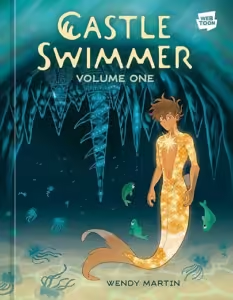Castle Swimmer: Volume 1
Wendy Martin
Ten Speed Graphic
Published October 22, 2024
Amazon | Bookshop | Goodreads
About Castle Swimmer: Volume 1
In the gorgeous first installment of the hit Webtoon series Castle Swimmer, two young mermen reject their destinies and embark on an epic adventure full of romance and danger, featuring exclusive bonus material.
From the moment Kappa tumbles into existence on the ocean floor, his life’s purpose is already decided for him: He is the Beacon, a light to all sea creatures, and destined to fulfill their many prophesies. In high demand and under immense pressure, Kappa quickly realizes that fame and glory are small compensation for a life of predetermined self-sacrifice.
Unable to resist the call of destiny due to a magical yellow cord that appears from his chest and pulls him inexorably to any sea creatures he swims by, Kappa ultimately finds himself drawn to the Shark kingdom, where he is immediately imprisoned. The Sharks’ prophecy states that the curse maiming their people will only be lifted once their prince, Siren, kills the Beacon. But when Prince Siren decides to defy fate and help Kappa escape, Kappa realizes that there might be more to life than fulfilling endless prophecies, leading to a raucous adventure as big and unpredictable as the ocean itself—and a romance that nobody could have predicted.
Episodes 1-19 of Webtoon’s Castle Swimmer Season 1 is collected in this stunning graphic novel, which also includes a never-before-seen bonus chapter featuring Kappa and Siren.
My Review
I love the illustrations in this beautiful undersea story. One character has a glowing force inside him that leads him to people he’s supposed to help. The panels really capture that illuminated look of the glowing force. The different underwater kingdoms include merpeople based on different sea creatures, such as sharks or crustaceans, which I thought was clever. I’ve never seen that done before.
The characters’ expressions can be a bit exaggerated and cartoonish. I enjoyed the anime feel of some of their reactions to things. The story follows both Kappa, the beam, and Siren, the prince who must kill him if he’s to fulfill a prophecy and break the curse on his people. It shows their loneliness and the growing bond between them, which really drew me into the story.
The backmatter contains a couple of short stories about Kappa and Siren, too. They’re so sweet. I will definitely be on the lookout for more of this series. It’s perfect for anyone interested in a high-stakes, sweet fantasy story under the sea.
Content Notes
Recommended for Ages 10 to 14.
Representation
Two boys appear romantically interested in one another.
Profanity/Crude Language Content
None.
Romance/Sexual Content
Two boys appear to be romantically interested in one another.
Spiritual Content
A god who lives at the surface of the ocean sends a creation called the Beam to fulfill the prophecies of mer people living under the sea. One group was cursed after they attacked another god. They believe breaking the curse involves a blood sacrifice.
Violent Content
Situations of peril. Brief scary ocean monster imagery. Brief battle scenes showing cartoon violence.
Drug Content
None.
Note: This post contains affiliate links, which do not cost you anything to use but help support this blog. I received a free copy of this book in exchange for my honest review. All opinions are my own.
